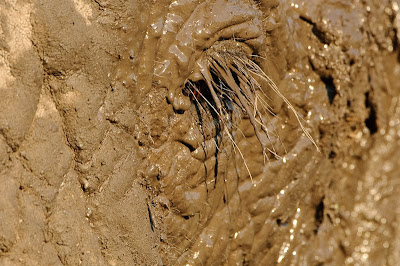Day 3 and 4
We returned to the leopard kill in the morning to find that the famous tree-climbing lions of Chiefs Island had climbed high into the thorny acacia and pulled down the carcass. The leopard was nowhere to be found of course, but the lions were great subjects in the early morning light. From there we spent time at one of the drying pools of water photographing yellow-billed storks fishing. The number and diversity of birds in the delta is something to behold- and it is one of the best places for bird photography.
The afternoon was a time to experience the mokoros of the Delta. This pirogue like boat is the best way to experience first hand the quiet tranquillity of the waters. It is also great for landscapes and macros photos. From there we spent time with some wattled cranes, a delta speciality, feeding and displaying. Our sunset sundowner was a mix of photographing zebra’s backlit into the setting sun and 5 bull elephants walking quietly past our vehicle, some 20m away. We almost didn’t have time to finish our drinks!
Day 4
This morning we spent 45 minutes at a small lagoon. It was a great spot for all sorts of action. Hippos fighting and yawning, squacco heron fly bys, fish eagle hunting and a slaty egret fishing nearby. From there we headed north and into some spectacular woodland and onto some open floodplains. Herds of lechwe greeted us. Three male lions and a leopard nearby also greeted us- we literally had our choice! That was until we had to pull the other vehicle out trying to cross the channel. Just another part of the delta experience! On the way back to camp we had baboons with babies to entertain our cameras- and us just the right way to finish off a drive.
The day had started with some cloud and it built up all afternoon with a large storm brewing up in the east. With the sun still shining in the west, this gave us some beautiful and intense light. First up it was some baboons backlit, their fur picking up the halo of light beautifully.
Then the wind started blowing strongly at the approach of the storm and looking in the east we saw a rainbow developing, so we hurriedly went in search of some subjects. First up was a palm tree- an icon of the Okavango, then some lechwe and impala with the rainbow right on top of them. The intensity of colour was so strong that you didn’t need a polariser to capture the beauty of it.
Nearby we found two male lions. The quality of light on them was perfect, and then the wide-angle image of a dark and moody sky with the rainbow in the background was just the cherry on top. Brilliant in all respects!
Day 5
The last morning led us out to the floodplains for the last time and we spent quite a bit of time with a herd of 500 buffalo, photographing them, the egrets and the oxpeckers in various modes. We found a very productive pool with lots of birds in, which we decided to stay at. It paid dividends as no more than 8 species of birds came within 5m of our vehicle. The pied kingfishers hovering right next to us was a highlight, as was the slaty egret hunting 2m from the vehicle. This was a perfect way to end another very successful workshop with C4 Images and Safaris.
After lunch it was I the charter flight and off to Maun for the quick flight back home. The beauty of the Okavango is that it is so remote, yet you can access it via charter flights in no time at all. Perfect for a photo workshop like ours to maximise your photography time and minimise your travel time.
Click here to see part 1 of the report.
And click here to read Isak Pretorius's feedback.










No comments:
Post a Comment